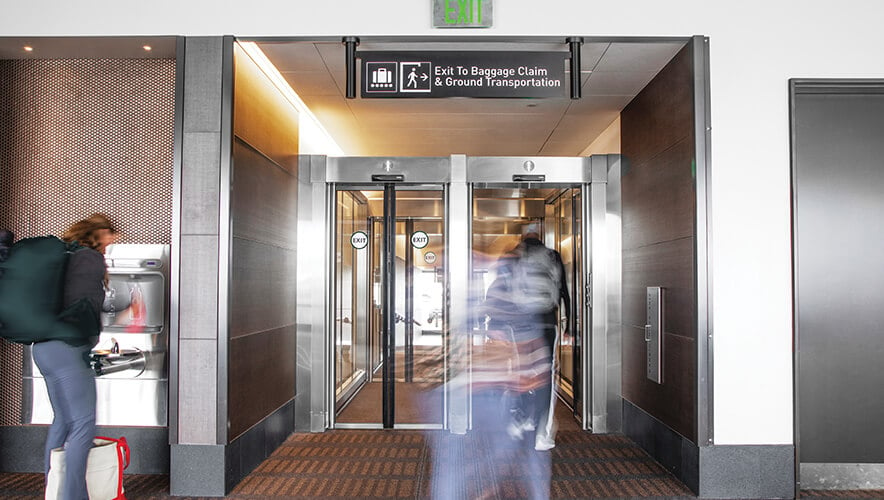A Washington Airport Boxes Out Security Breaches
In 1936, as air travel was gaining popularity, Paine Field was built by an American New Deal agency, the Works Progress Administration, with the goal of becoming an early commercial “super airport” for the United States in Snohomish County, Washington.
Although World War II changed the fate of the airfield, Paine Field continued on, wearing many hats throughout the decades—with the roughly 1,000-acre site serving as a general aviation airport, a military base, and a site for a Boeing manufacturing facility. Adding to the field’s résumé, Snohomish County recently partnered with Propeller Airports to revive the commercial terminal, developing and operating the state’s second public commercial airport.
Paine Field, also called Snohomish County Airport, presently has two airlines flying out of the public terminal. They serve major markets along the West Coast: Alaska Airlines, the terminal’s launch partner, and United Airlines, which operated at the airfield when it originally opened.
While separate from other aspects and operations in the area, Propeller and its chief operating officer, Mark Reichin, understood that this airport would need to meet the same security standards as others, including robust exit lanes.
The terminal, which officially opened in March 2019, serves about 2,000 people every day. Each person must go through Transportation Security Administration (TSA) screening to reach the gates, or the “air side.” A point of concern where breaches could occur is the exit lane area—the corridor that allows disembarking passengers to reach the baggage claim area, or “land side”—typically surveilled by only one or two TSA agents. If someone turns back—whether to retrieve a forgotten cell phone or do something more nefarious—it’s a breach, says Reichin.
Reichin was looking for a security product that could help prevent such breaches, even in situations that would otherwise overwhelm security personnel manning the exit lane. Propeller selected a dormakaba exit lane breach control unit, partly because it would not require additional personnel and partly because of the company’s customer service.
“We just felt it was more efficient to automate the exit lanes, utilizing the technology from dormakaba,” Reichin says.
After landing on the product, Propeller and its general contractor coordinated with dormakaba’s team for physical access solutions so that the unit could be placed while the terminal was still under construction. Although the unit’s physical construction was relatively easy, installing and properly wiring the unit’s electronic, sensor, and software components demanded the better part of two weeks.
According to Bill Seibert, business development manager for airport solutions at dormakaba, having the producer install the unit ensures that qualified persons—either dormakaba installers or someone certified by the company—will correctly install the corridor, minimizing potential liabilities.
Seibert’s team also trained airport staff on everything from maintenance procedures that will keep all the sensors clean and accurate to understanding the various security and alarm indicators that alert the terminal’s control center.
Communicating with staff and coordinating the scope of work was crucial to a successful installation and operation, Seibert says.
Reichin adds that after installation there were a few minor “teething” issues with the unit’s sensors and alignments; however, dormakaba representatives remained at the facility to work out the kinks.
“To be honest, knock on wood, it’s been relatively trouble-free since we went live,” says Reichin, who travels through the corridor at least 25 times every day. He estimates there have been one or two issues since the terminal opened for business, but they did not impede operations or demand an alternative to the security procedure, and the manufacturer quickly responded, at times even fixing the issue or updating software remotely.
The one-way exit corridor looks like an airlock from a science fiction film. Travelers heading to baggage claim leave the air side of the airport by passing through one set of automatic glass doors, which then close to usher individuals towards the automatic doors that operate as the entrance to the land side.
“The minute they go through, it will not allow them to swim upstream,” Reichin says. “They can turn around two seconds after entering the device, and the device will lock and not let them go backwards. If you turn around and sensors sense you walking back the other way, the unit locks down everything and sets off an alarm.” At this point, an automated recording tells the traveler that retreating to the air side is not allowed.
The corridor has an array of sensors: some monitor traffic through the corridor, others along the floor detect objects left behind by passengers, and sensors on the land side pick up on objects thrown through the unit. These help create a one-way corridor that prevents breaches and controls those passing through. The system also enables the airport to identify anyone or anything trying to bypass security between the land side and the air side.
Even when someone in the corridor realizes they left behind a cell phone, piece of luggage, pet, or child, they cannot turn around and plead their case to a TSA agent.
“It happens occasionally where somebody walks through and goes, ‘Oh my God! I left my child there!’” Reichin says. “You can’t go back, but…if there is an issue, we’re there to help and take care of any problems.”
Besides the initial growing pains resolved by reconfigurations, as well as regularly scheduled maintenance, Reichin adds that no other changes were needed.
Paine Field’s experience with the corridor, especially its continued success in preventing breaches, has satisfied and sold Propeller on the product. “It has never once left us unable to function,” Reichin says.
For more information: Dormakaba, Bill Seibert, 704.774.7368
